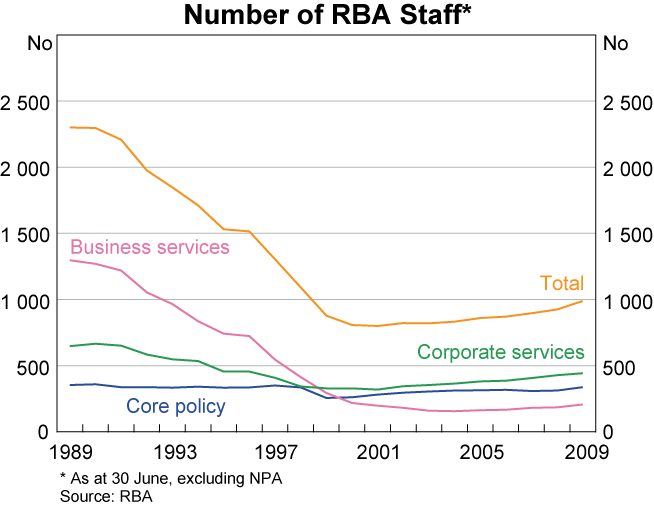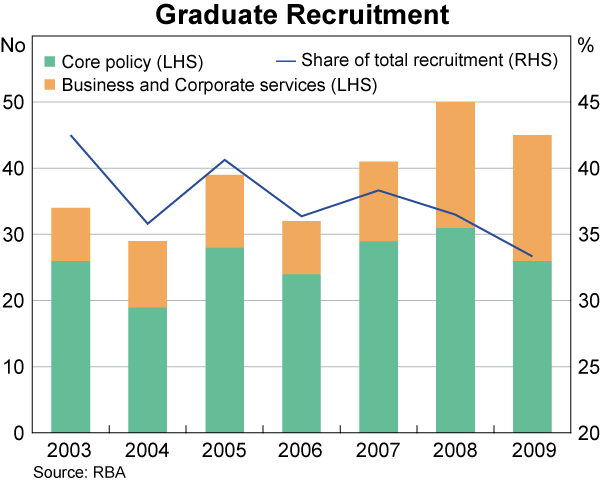Reserve Bank of Australia Annual Report – 2009 Management of the Reserve Bank
Operating Costs
During the year, the Reserve Bank was required to undertake a range of new or additional activities in response to the global financial crisis. These included: establishing arrangements to administer the Government Guarantee Scheme for Large Deposits and Wholesale Funding on behalf of the Australian Treasury; additional new banknotes to meet increased demand for cash; increased staffing to monitor developments in global financial markets, including the international policy response; higher transaction costs associated with more active operations, especially in domestic markets; and additional costs associated with the issuance and processing of cheques for the Government's stimulus payments. Some of these involved additional staff and new investment in systems and equipment. Others pushed up costs by reducing the amount of leave taken and increasing overtime, while the significant depreciation of the Australian dollar increased the cost of overseas operations. These direct and indirect costs flowing from the financial crisis added substantially to the Bank's running costs for the year. Of course, the financial crisis also added to the Bank's revenues, as outlined in the chapter on ‘Earnings and Distribution’.
More generally, the rise in the Reserve Bank's costs also reflected a restructuring of its activities in relation to currency printing, issue and distribution, to strengthen the governance of operations at Note Printing Australia (NPA) and Securency and ensure the integrity of the Australian banknote issue. The ongoing program of enhancing the functionality, resilience and security of IT systems continued. Key systems developed further in 2008/09 were the platform for the interbank payments system (RITS), the Bank's trading system and the transactional banking system. These IT systems are pivotal to ensuring the continuity of the Bank's operations, which are of systemic importance.
In total, operating costs in 2008/09 were $215.4 million, an increase of about 9.7 per cent from the previous year.
| 2000 /01 |
2001 /02 |
2002 /03 |
2003 /04 |
2004 /05 |
2005 /06 |
2006 /07 |
2007 /08 |
2008 /09 |
|
|---|---|---|---|---|---|---|---|---|---|
| Staff costs | 67.7 | 73.9 | 77.8 | 85.5 | 91.4 | 101.0 | 110.2 | 119.1 | 132.6 |
| Other costs | 54.1 | 58.4 | 62.7 | 58.6 | 68.8 | 73.1 | 74.7 | 77.2 | 82.8 |
| Underlying operating costs |
121.8 | 132.3 | 140.5 | 144.1 | 160.2 | 174.1 | 184.9 | 196.3 | 215.4 |
| Cost of redundancies |
2.6 | 3.4 | 2.6 | 0.2 | 0.2 | 0.2 | 0.2 | 0.2 | 2.0 |
| a) Costs associated with the ongoing operation of the Reserve Bank, excluding NPA | |||||||||
More than half of the Reserve Bank's operating costs arise from the conduct of its responsibilities for monetary and payments system policies, including operations in financial markets; about a quarter are associated with providing banking and settlement services, including the real-time interbank settlement system and transactional banking services for the Australian Government; and about 16 per cent of operating costs arise from issuing banknotes.
Expenditure on staff represents the Reserve Bank's largest cost, accounting for around 60 per cent of total operating costs including remuneration, on-costs and other related costs for training, recruitment and the like. Redundancy payments are also made from time to time when work practices are redesigned to meet changing business requirements or to improve the efficiency of operations; in 2008/09, these payments amounted to $2.0 million.
Our People
Reflecting additional activities, the Reserve Bank took on more staff during the year. As at the end of June 2009, the total number of employees at the Bank was 989, an increase of 63, or 6.8 per cent, from the previous year. The direct impact of the global financial crisis on staff numbers was felt mainly in new positions created to administer the Government's Guarantee Scheme. The indirect effects were felt more widely. These included changes in work programs as new challenges have arisen; higher payment settlement volumes and peak loads; and increased banking activity associated with the Government's economic stimulus payments and variations to systems as a result of the Bank's changing collateral requirements. The restructure of the Currency Group resulted in a transfer of some banknote research and development functions and staff from NPA, which also added to staff numbers in 2008/09. In addition to research and development activities, this group now has greater responsibility for the administration and examination of counterfeit banknotes, activities that were previously handled by the Australian Federal Police. New staff were also added to support the Bank's information services.

Most of the increase in staff numbers was concentrated in Head Office. Fifty-eight staff, or just under 6 per cent of the Bank's workforce, are now working at the Bank's business resumption site, reflecting the Bank's ongoing focus on risk management and contingency planning.
The Reserve Bank continues to recruit a large number of graduates. Forty-five joined the Bank's Graduate Development Program this year, compared with 50 last year. The trend to a higher representation of recruits from fields other than economics and finance continues, with areas such as law, accounting and information technology well represented. Increasingly, these graduates are working in the Bank's business and corporate services areas. Graduates account for around one-third of the Bank's annual recruitment. This share has fallen slightly over the past few years as the number of people hired on fixed-term contracts to work on Bank projects has increased. The Bank sources graduates primarily from across Australia in the interests of recruiting the best talent. The Bank eased its citizenship requirements for employment to allow more flexibility in engaging employees from overseas with specialist knowledge and experience. Where a position requires a security clearance, however, the incumbent must still be an Australian citizen.

The Reserve Bank also employs around 15 to 20 staff each year under its traineeship scheme. The scheme is designed to assist those without qualifications to enter the workforce, with formal training (and accreditation) forming part of the program.
Staff turnover in 2008/09, at around 9 per cent, was smaller than in previous years, partly reflecting the weaker labour market conditions generally. Turnover remains low by industry standards.
The Reserve Bank strives to offer a total reward package that attracts and engages high-calibre employees. The majority of staff are employed on individual contracts, which provide flexibility in remuneration based on performance and market relativities. The Bank also negotiated a Workplace Agreement with the Finance Sector Union, which runs for two years from December 2008. Staff, on average, received a salary increase of 4 per cent in 2008/09, with scope for a modest additional payment in recognition of good performance.
Part of the reward structure is the opportunity to engage in continuous professional development with Reserve Bank support. Forty-eight staff received financial support for further study during the year, including four who commenced full-time post-graduate study at overseas universities. Other training is provided by on-the-job experience, formal training courses and, for a limited number of staff, attachments to other organisations. Over the past year, for example, the Bank has had staff on secondment with APRA, the Australian Securities Exchange, the IMF, the Reserve Bank of Vanuatu and the BIS. At the same time, the Bank has hosted secondees from the Bank of England and the Reserve Bank of India.
Facilities
The Reserve Bank owns premises in locations where there is a business need to do so, including its Head Office building in Sydney, office buildings in Melbourne and Canberra, the note printing facility north of Melbourne and the business resumption site in outer Sydney. In addition to the buildings it owns, the Bank leases accommodation for the State Offices in Adelaide, Brisbane and Perth, where demands for space are quite small. The Bank's Representative Offices in London and New York also occupy leased premises.
The value of premises assets in Australia, which is appraised annually by external valuers, decreased by a net amount of $28 million to $337 million in 2008/09, reflecting the widespread softening of the Australian commercial property market. Surplus accommodation in premises owned by the Reserve Bank is leased to external tenants; gross income from these leases amounted to $7.5 million in 2008/09.
During the year, the Reserve Bank continued to strengthen the resilience of facilities supporting critical operations. At its Head Office, this involved establishing an IT operations centre to monitor the performance of the Bank's key systems and accommodation to support the Bank's role in the Government Guarantee Scheme. In Victoria, the electrical power supply and other critical building services were upgraded to meet the expected future operational demands of NPA.
Environmental Management
The Reserve Bank continues to develop initiatives to reduce costs and promote sustainable practices in its operations. During the year, building services were upgraded, leading to improvements in energy and water efficiency. These steps included the upgrade of the air-conditioning plant at NPA and the improvement in building services controls at Head Office. The Bank also continues to measure the impact of environmental initiatives, with the following results in 2008/09:
- a reduction in consumption of electricity of 0.3 per cent;
- an increase in the consumption of gas of 1.6 per cent;
- a reduction in consumption of paper of 3 per cent, with three-quarters of paper now 50/50 recycled, more than double the proportion the previous year; and
- the Bank's fuel efficiency is well within the Commonwealth's green guidelines for vehicle fleets.
Waste recycling was extended to all of the Reserve Bank's facilities during the year. About 60 per cent of waste from the Bank's mainstream activities was recycled in 2008/09. New technology for recycling water used in the printing process at NPA has reduced water use by about 90 per cent to 3,000 litres per day.
Consultancies
The Reserve Bank employs outside contractors or professional service providers to carry out specific tasks where necessary, and also, from time to time, uses consultants. In 2008/09, the following two consultancies were undertaken.
| Consultant | Project | Cost ($)(b) | Purpose |
|---|---|---|---|
| Deloitte Touche Tohmatsu | Peer review of Audit Department | 41,070 | Assessment of audit process and compliance with standards |
| Open Link International Pty Ltd | Upgrade of trading system | 21,600 | Pre-upgrade quality assurance review and report |
| (a) Costing $10,000 or more (b) Excluding GST |
|||